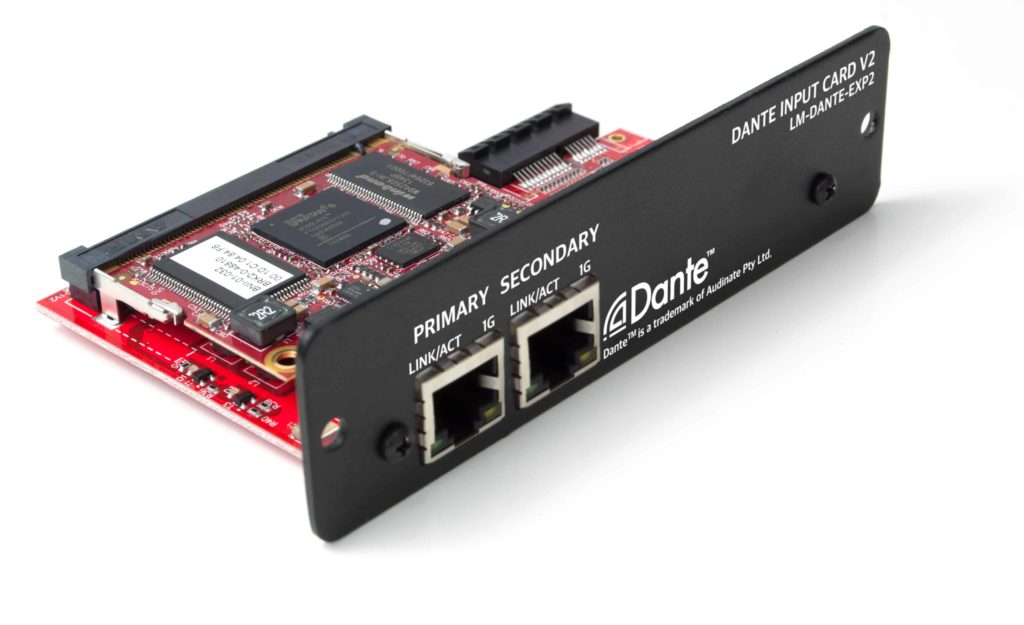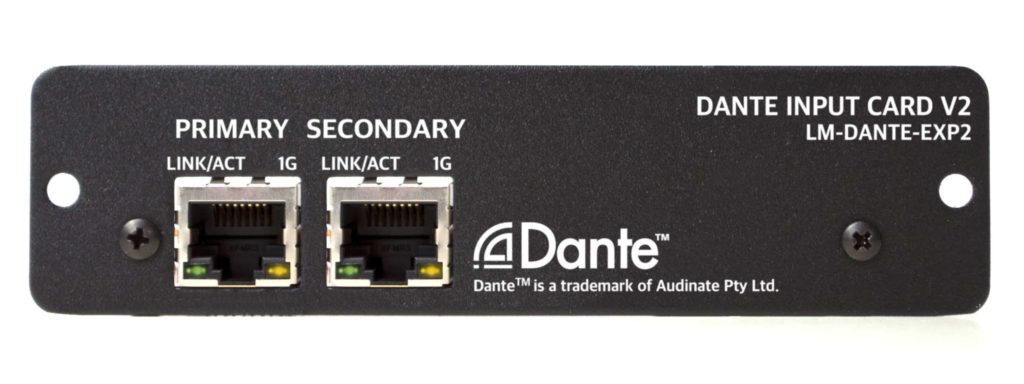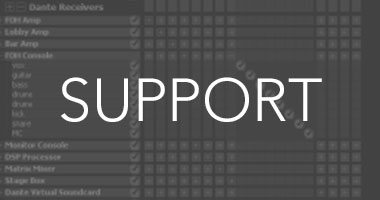The Livemix LM-DANTE-EXP2 is a user installable option card for the MIX-16 and MIX-32. This input option card is for connecting to your Dante digital network. Audinate’s Dante technology is a widely accepted and highly reliable standard for networked audio, especially in live and studio sound applications. When using the Dante input option card (LM-DANTE-EXP2), the Livemix system integrates seamlessly into a Dante network. All the network subscriptions can be made with the free Dante Controller from Audinate. Now AES67 Compatible.
FEATURES

Option Card for MIX-16 & MIX-32
The Dante Option Card for the MIX-16 and MIX-32 makes it incredibly easy to connect your Livemix system to a Dante™ network. It is preinstalled in a Livmix digital system and can be user installed if upgrading from the Livemix AD-24 analog input.

Receive up to 24 channels from multiple Dante™ devices
Livemix can receive audio from any published Dante™ stream. Assign Dante channels from a single device or multiple devices to make up the 24 channels available for personal monitor mixing.

Up to 96 kHz + 24-bit Audio
The LM-DANTE-EXP2 receives 24-bit audio at up to 96kHz digital audio directly from the Dante™ network.
DOWNLOADS
Please visit the Support page for the latest firmware downloads.
| LM-DANTE-EXP2 | |
|---|---|
| Input Channels | 24 |
| Bit Depth | 24 bit |
| Supported Sample Rates | 44.1kHz 48kHz 88.2 kHz 96 kHz |
Yes you can, and it it incredible simple. Select the channel within the group that you wish to adjust. A white border will outline the channel to indicate it is selected. LONG PRESS the ADJUST knob to temporarily remove the channel from the group. The white outline of the selected channel will flash while the channel is temporarily out of the goup. Use the ADJUST knob to adjust the volume of the channel and press the ADJUST knob to return the channel to the group.
You can connect two CS-SOLO units to a single port on the MIX-16 or MIX-32. The first mixer is the blue “A MIX” while the second unit will be the red “B MIX”. Power and audio is supplied to the second CS-SOLO over a network cable connected to the CS-SOLO THRU port. The CS-DUO must be connected directly to the MIX-16 or MIX-32.
The CS-DUO has the abiblity to link both the A and B Mixes. Select the A mix, PRESS and HOLD both Master Volume knobs at the same time. Confirm that you want to group the controls. At this point both sets of control knobs will control the mix. Repeat these steps to unlink the mixes.
The Auxiliary input is designed for an amplified signal such as what is output from a smartphone headphone output. In order to use a microphone with the Aux input, it would need to be used with a microphone preamplifier before the signal gets to the Livemix Aux in.
But as luck would have it, we make just such a device. The LM-MICPRE is a mic preamp that allows you to use a standard dynamic mic as the intercom mic. Check it out here.
While Livemix Data is transmitted over standard network cables, it is not in a format that a network can read. DO NOT use splitters, couplers, or hubs between any CS-SOLO or CS-DUO and the MIX-16/MIX-32. DO NOT connect a CS-SOLO or CS-DUO into an ethernet network. This could cause damage to the personal mixer and will void the warranty.
While Livemix Data is transmitted over standard network cables, it is not in a format that a network can read. DO NOT use splitters, couplers, or hubs between any CS-SOLO or CS-DUO and the MIX-16/MIX-32. DO NOT connect a CS-SOLO or CS-DUO into an ethernet network. This could cause damage to the personal mixer and will void the warranty.
Shielded cable is required for connecting both the AD-24 and the DA-816 to the MIX-16 or MIX-32. Shielded cable is not required for connecting a CS-SOLO or CS-DUO to the MIX-16/32 or connecting the LM-DANTE card to the Dante network. However, shielded is recommended.
Livemix has 5 multi-channel groups, one of which is controlled with the Me Knob, and up to 12 stereo “group” links. Using this feature, you can group two channels (Stereo Keys, Guitar, Tracks) but because it only groups the volume, you can still have the ability to use the full stereo field.
Livemix has 5 multi-channel groups, one of which is controlled with the Me Knob. These groups can contain any number of channels. Livemix also supports stereo pairs. Adjacent channels can be grouped into stereo pairs for easy volume adjustments for stereo channels like keyboards and tracks.
To remove the passcode, PRESS the ME Knob for three seconds on any screen that prompts you to enter the passcode. After three seconds, release the ME Knob and PRESS and hold it for three seconds more. The passcode removal screen will appear. SELECT Yes to reboot the system, removing passcode protection.
Because Livemix was designed to be volunteer friendly and easy to use, setting up effects for each channel can be done globally from one personal mixer. Setting up EQ and compression on 24 channels for every person on stage would be a nightmare (with the MIX-32 that would be 768 channels). With global effects, each channel can be optimized to fit in a mix perfectly so that each performer just needs to adjust volume and pan.
Livemix auto saves settings and mixes to a temparary location every 2 minutes. If you make an adjustment and power down without saving before it has a chance to auto save, you will lose your changes. It is recommended to always save a mix or global template when changes are made.
Through many years of working with worship teams, volunteers, and live bands, we have found that most musicians are not used to mixing multiple channels. We designed Livemix with this in mind. Additionally, it is much easier to offer help to another performer (or use MirrorMix®®) when the channels are in the same locations from personal mixer to personal mixer.







